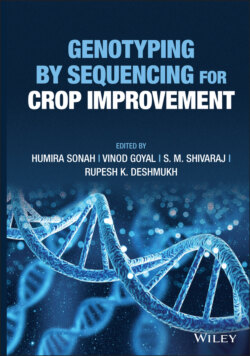Читать книгу Genotyping by Sequencing for Crop Improvement - Группа авторов - Страница 52
Genotyping‐by‐Sequencing (GBS)
ОглавлениеGenotyping‐by‐sequencing (GBS) is also a next‐generation sequencing‐based SNP genotyping method that uses restriction enzymes to reduce the genome complexity. GBS only targets as little as 2.3% of a genome. This reduced representation can be achieved by digestion of genomic DNA with methylation‐sensitive restriction enzymes (REs). Methylation‐sensitive REs do not cut repetitive DNA because of its highly methylated in nature and hence digested fragments generated from low‐copy genomic regions. This helps in avoiding the repetitive regions and targeting low copy regions of the genome (Elshire et al. 2011). In GBS, genomic DNA is extracted and digested with methylation‐sensitive restriction enzymes. Illumina sequencing forward and reverse adaptors ligated to both the end of fragments. The forward adapter is enriched with barcode sequences which is helpful for multiplexing of the samples. Now the PCR amplification is performed using stranded pair‐end Illumina primers. The PCR is used to amplify the GBS library and add the Illumina sequencing regions to the fragment. The prepared GBS library was sequenced using Illumina platform and generated data were analyzed using bioinformatics software’s like Next Generation Sequencing Eclipse Plugin (NGSEP), TASSEL‐GBS, R package msgbsR, etc. (Perea et al. 2016; Wickland et al. 2017).
